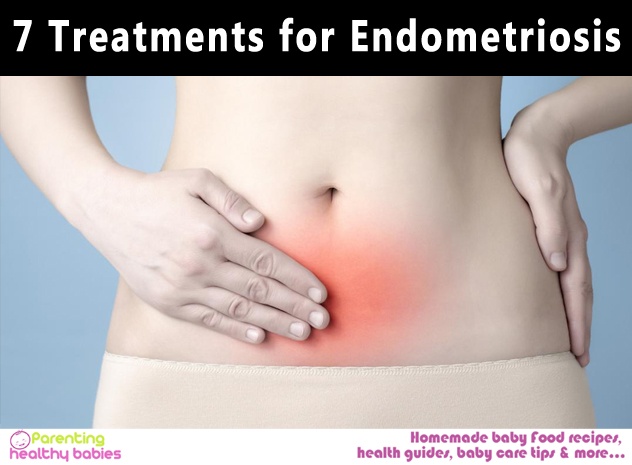What is endometriosis? It is an abnormal growth of endometrial or uterine tissue outside the walls of the uterus, usually near the opening. This tissue is shed every month during the menstrual cycle. There are implants of endometrial tissue found on the ovaries, fallopian tubes, bowel, membrane that lines the pubic cavity, and the surface of the uterus.
Endometriosis is a fairly common disease among women nowadays, which is a possibility of its low rate of timely diagnosis. The symptoms and the effects of endometriosis must be kept in mind for appropriate medication and treatment. Some of the most common symptoms that must be recognized in order to propagate endometriosis treatment in due time are chronic pelvic pain, extreme irregularities in the menstrual cycle, painful sexual intercourse, infertility, chronic lower back pain, intestinal pain, concentrated blood clots during menstruation, and painful passing of urine or stool. Endometriosis treatment becomes easier to follow once these symptoms are identified.
Read More: 5 Herbs For Strengthening The Uterus
The treatment process falls into three broad categories, consisting of different approaches:
- Pain Medication – Pain killers
- Hormone Therapy – Oral Contraceptives, Progesterone, Gonadotropin-releasing hormone agonist, and Danazol
- Surgical Treatment – Laparoscopy and Laparotomy
Ranging across these core categories, there are seven most common treatments as discussed below:
Common Treatments for Endometriosis
Pain Killers
Tablets that come as pain killers are the most common form of endometriosis treatment. However, this method is only useful when the pain and other symptoms are mild, usually in the very first stage of the disease. Common pain killers that are available over the counter and are prescribed by doctors are non-steroid anti-inflammatory drugs called NSAIDS and opioids, which directly interact with the nervous system in attempting to reduce the trauma.
Oral Contraceptives
These are pills that help women ease their period cramps and pains, experience a lighter period, and follow a more regular menstrual cycle. This endometriosis treatment comes in the form of two categories of oral pills, both of which contain estrogen and progestin. The first and more usual type of pill is the one that affected women must take for 21 days in a row and then take a break for 7 days during which they take sugar pills. During those 7 days, they bleed like they do during menstruation. The second type of pill entails regular intake without any sugar-pill breaks for 3 months or as long as the doctor’s prescription mentions.
Progesterone
This another common hormonal method of endometriosis treatment. This hormone is taken via pills, injections, or through an intrauterine device (IUD). This helps reduce women’s periods or stop them completely. As a pill, if taken daily, the hormone reduces menstrual flow without making the lining of the uterus outgrow. As an injection, progesterone is taken every 3 months, which causes the menstrual flow to come to a halt. Once the injection is stopped, menstruation starts again. This method, however, may be painful for some women in the first year, as they may experience pain and bleeding till the time their bodies become accustomed to this. IUD is another form that enables reduction in pain stemming from endometriosis, by reducing menstrual flow for a period of time.
Gonadotropin- releasing Hormone (GnRH) Agonist
This hormonal method of endometriosis treatment stops the production of specific hormones that aid ovulation, menstruation, and the increase in endometriosis. This puts the body into a state of artificial menopause. GnHR agonist comes in three forms, as a daily nose spray, as an injection taken once a month, and as an injection taken once in three months. Majority of the doctors treating endometriosis recommend this treatment for about 6 months, because longer periods may lead to loss of bone density and depreciation in heart health. With discontinuation of the hormone, the menstrual cycle returns.
Danazol
This is a treatment that halts the release of hormones that make the menstrual cycle function. This hormonal therapy leads to women getting their periods once in a while during the initial stages, and then not at all in the later stages. The medicine is taken in the form of a medical drug that can be acquired by flashing the doctor’s prescription. This treatment often comes with unfortunate side effects. The most common side effects are allergy attacks, oily skin, increase in weight, tiredness, ans sore breasts. A more serious side effect is that this hormone can interfere in the development of a foetus.
Laparoscopy
This is a surgical method of endometriosis treatment in which a surgeon inflates the abdomen slightly, using a harmless gas, and inserts a tiny viewing instrument into the abdomen, which is called laparoscope. The surgeon then makes at least two more small cuts in the abdomen and inserts lasers to remove the lesions through a process called excising. The lesions are destroyed by using intense heat and the blood vessels are sealed without stitching, by a process called cauterizing. Sometimes surgeons also remove the scarred tissues as they might add to the pain of endometriosis.
Laparotomy
A major abdominal surgery is conducted by doctors in this form of endometriosis treatment. The endometriosis patches are removed, and at times the uterus is also removed for ensuring safer recovery. Removal of the uterus in this case is also called hysterectomy. Senior healthcare experts suggest that a major surgery should be the last option for treating endometriosis.
Endometriosis is a disease that women all over the world are contracting, mainly due to lifestyle changes and climatic conditions. While it is important to look into the disease by understanding the symptoms, it is also important to keep in mind the quick, common treatments for endometriosis. Regular health check-ups and careful diagnosis is the key to timely treatments, which are available in different categories, in relation to the patients’ conditions.













